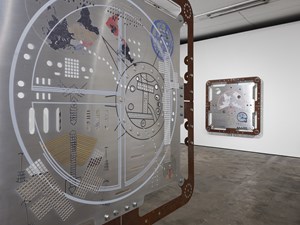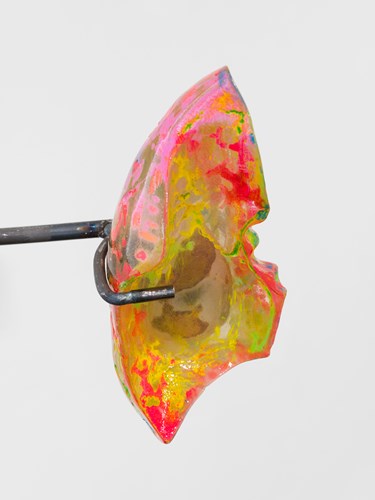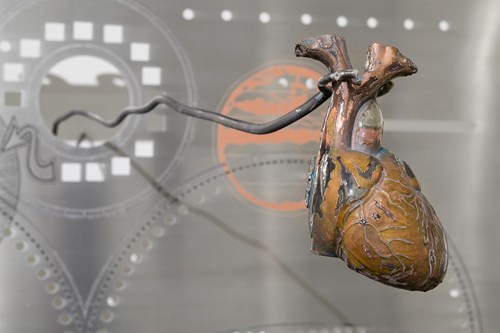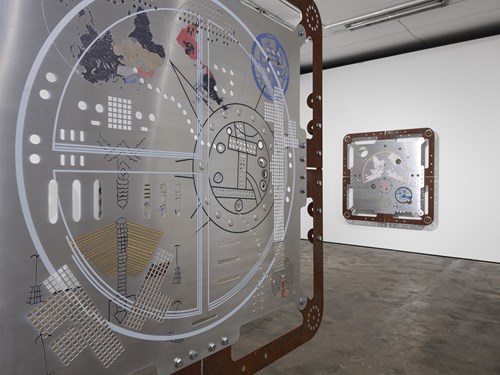ArtDependence talks with Mariechen Danz on the creation and impressions of Ore Oral Orientation, exhibited at Wentrup Gallery. Danz shares her inspirations for, and visions of its potential impact on audience perceptions.
ArtDependence: Your works in this Wentrup exhibition make me think of a not-so-distant, possibly science fiction future. It seems as though the organs are connected to computer parts, gaining energy or intellect. I like to refer to the work as learning organs. Is that a correct interpretation ?
Mariechen Danz: That is an interesting interpretation, but not my intention. The punched and embossed metal plates are all preexisting templates that allow or support the transfer of information. For example, venting systems, usb or vga sockets and other plugs and spaces for various methods of technological connections . The fundamental interest here is in what the shifting forms of knowledge transfer and communication look like. I have arranged them freely across the maps printed on the plates to create pathways and in their shadow form they create new, independent maps of their own. The maps printed on the plates are all edited to focus on the land or sea. They are chosen from a list of the history of world maps from Babylonian times through the 20th Century and layered often upon each other. Additionally, there are some organs or anatomical drawings taken from an archive of the history of anatomy. The organ sculptures have different processes; not all are learning organs. That title refers to those mainly containing the ABC letters of the Latin alphabet. Others are contemporary soil samples, e.g. soil or trash, etc. Others are filled with stones or minerals in order to begin the fossilisation process of the organs themselves, instantly locating them in multiple geographical locations and timelines.
The placement of the organs serves to mark locations on the maps and represents the bodies and the people who contributed to the communication of these maps, hence the title Ore Oral Orientation. They are mostly made up of gathered stories from different travellers and then combined to create a map of the world. Some are also only interpretations as many of the maps don’t exist any more and therefore are drawings that were done e.g. 14 Century based on communication of an earlier map. They are nearly always translations or involve that process. My interest here is in heightening the role of subjectivity in history, especially in roles that assume a neutrality and within them carrying the destruction and erasure of the colonised culture they describe.
I work with the organ sculptures to move away from the hierarchy of the brain as the primary location for learning, evaluating the functioning of other central organs alongside it, considering alternative forms of knowledge transfer and the role the body plays in these processes.
I understand the association with sci-fi and futuristic, however, what interests me is that each of these elements are pre-existing, ancient or contemporary and in use. I have brought them together to show that in reality these are not foreign elements, but everyday (in the form of the technological reference through sockets etc from Machinery or electronic devices ) or literally inside our bodies as the organs.
That is a long answer and not concise, but I hope helpful nonetheless. :)
Mariechen Danz, Knot in Arrow: Ore Oral Orientation, 2017, Performance, Viva Arte Viva, curated by Christine Macel, 57. Biennale di Venezia, (film still), Courtesy Mariechen Danz
Mariechen Danz, "Ore Oral Orientation" exhibition at Wentrup Gallery. In cooperation with Genghis Khan Fabrication Co., digital print on punched and embossed aluminium, rusted steel. Courtesy of WENTRUP, Berlin. Photo: Trevor Good
Mariechen Danz, "Ore Oral Orientation" exhibition at Wentrup Gallery. In cooperation with Genghis Khan Fabrication Co., digital print on punched and embossed aluminium, rusted steel. Courtesy of WENTRUP, Berlin. Photo: Trevor Good
AD: Or like you said in a panel discussion at Haus der Kunst: “fossilise organs"?
MD: There are bones, or in the case of bog-bodies or mummies preserved skin, but that is all what remains of our bodies. I wanted to fossilise the organs themselves as our understanding of our own body is always changing and full of errors. Society has always been structured around concepts of the body, even when they were completely wrong such as Galen. This continues now in the present with examples such as the 2017 declared "new” organ the mesentery, or the 2018 “new” organ, the interstitium.
AD: You work together with the Genghis Khan Fabrication Co., how did this collaboration start and what is the “extra” in your work from working with them?
MD: Genghis Khan Fabrication is a project by the artist Alvaro Guillen, see the description below. We met whilst studying at Calarts in California in 2007 and began collaborating in 2009. We have created the modular glyphic system works since 2013 which inspired these newer modular maps. We share an interest in concepts of unlearning and look to alternative, subaltern or erased formats of knowledge transfer beyond the hierarchy of the European Project of modernity and especially the limits of 26 letters of the Latin alphabet. It is the challenging and confrontational collaboration due to our distinct backgrounds and views that leads to these works, I would say.

Mariechen Danz, "Ore Oral Orientation" exhibition at Wentrup Gallery. In cooperation with Genghis Khan Fabrication Co., digital print on punched and embossed aluminium, rusted steel. Courtesy of WENTRUP, Berlin. Photo: Trevor Good
Mariechen Danz, "Ore Oral Orientation" exhibition at Wentrup Gallery. In cooperation with Genghis Khan Fabrication Co., digital print on punched and embossed aluminium, rusted steel. Courtesy of WENTRUP, Berlin. Photo: Trevor Good
Mariechen Danz, "Ore Oral Orientation" exhibition at Wentrup Gallery. In cooperation with Genghis Khan Fabrication Co., digital print on punched and embossed aluminium, rusted steel. Courtesy of WENTRUP, Berlin. Photo: Trevor Good
"Genghis Khan Fabrication Co. is a Silicon Valley USA based corporate entity founded in 2010 as an experiment in decoloniality. Its mission is to develop decolonial options through the development of new technologies, socioeconomic interventions, art works of its own making, and collaboration with artists. (www.alvaro.us)"
"Ore Oral Orientation" is on view at WENTRUP, Berlin until 28 July 2018.







